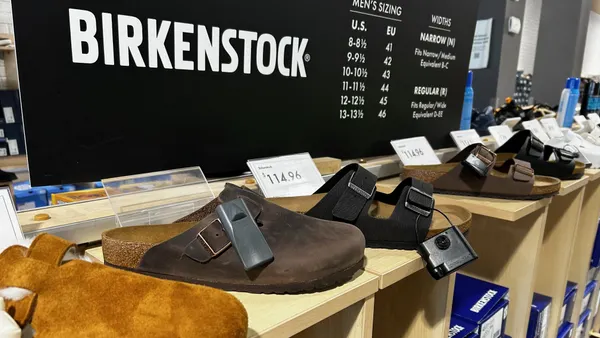When Mike Edwards stepped onto his flight from New York back to Ann Arbor, Michigan, in July 2011, he was the still CEO of the second-largest bookstore chain in the U.S. But the 40-year-old retailer was crumbling fast beneath his feet.
Edwards was in New York that day to submit a plan of reorganization and refinancing for Borders Group Inc. to a bankruptcy judge. Since filing for Chapter 11 bankruptcy in February 2011, Edwards spent months courting investors, asking them to throw Borders' sinking business a buoy of capital.
The deal was 90% done, Edwards thought in the days leading up to that flight. But at 5 p.m. the day before he was going to meet the judge, the CEO found out he would need to file an altogether different document: a plan for liquidation.
“It was at the last minute where [investors] backed out because they weren't comfortable with the publishers' support going forward — and they thought that would put the investment at risk, so they pulled the plug,” Edwards told Retail Dive in an interview about his last days as Borders' CEO.
Up to that point, Edwards maintained optimism that the once family-owned, Michigan-grown bookshop would emerge from its decline into bankruptcy. Under the turnaround plan he was spearheading, the idea was that Borders would come out smaller yet profitable. Now, Edwards found himself coming back to Michigan empty-handed — unsure of what he would tell his waiting employees.
A sinking ship
Founded in 1971, Borders grew from its Midwestern roots into a popular national bookstore chain after being bought for $190 million in 1992 by Kmart. Several years later, Kmart spun off its discount book chain Waldenbooks and Borders as a combined entity, calling it the Borders Group. In its prime in 2001, the company boasted over 1,200 domestic and international Borders and Waldenbooks stores.
At the turn of the century, Borders made a fateful move that looks especially bad in hindsight: The retailer struck a deal with Amazon to sell its books online, and it wasn't too long afterward that the retailer began to struggle. In the mid 2000s, the company's finances began to falter despite efforts to turn around the business, such as concept stores and a partnership with Starbucks. Borders lost $157.4 million in 2007 and put itself up for sale a year later.
Mike Edwards, a merchandising veteran with stints at Target and Lucy Activewear among others, first came to Borders in 2008. The retailer had already begun to shed hundreds of stores in its bid to stay afloat, and executives rotated in and out of the CEO position like a game of musical chairs.
Soon, it would be Edwards' turn. On Jan. 26, 2010, Ron Marshall resigned as Borders Inc.’s CEO after only a year at the helm. The board of directors then tapped Edwards, an executive vice president and chief merchandising officer at the time, to temporarily take over the role.
Edwards became the company's fourth CEO in five years. His post became permanent in the summer after Bennett LeBow was named CEO of parent company Borders Group. The tobacco executive had recently infused $25 million into Borders in an effort to pull the retailer up from a string of poor quarterly earnings. The company badly needed to stabilize its balance sheet and Edwards was set on making that his number one priority — it all seemed like a pretty simple task to him at the time.
“To me, it seemed like a quick turnaround with low stock base that potentially would set the company up for an acquisition within two or three years,” Edwards said.
If Borders was a traditional turnaround story, he thought, the retailer would need to downsize its store footprint and tune up its operations. But while Edwards was focused on negotiating the almost $100 million debt revolver Marshall left in his wake — $36 million of which had to be paid to hedge fund manager Bill Ackman that summer — one devastatingly important trend had quietly snuck up on him: the e-book.
The e-book effect
Amazon released its first Kindle e-reader in 2007 and it sold out within hours. Over the next few years, the trend grew and eventually culminated with the release of the iPad in 2010 — a device that was “petrifying” to Edwards and Borders' future.
“The iPad, in a sense, is a Borders store in your hand,” he said. “You have music, you have video and you have books. And you have access to the largest selection in the world and you don’t have to walk to a bookstore.”
That didn’t bode well for a model built on music, books, video and a café. With sales migrating online, Edwards realized that every Borders store — 25,000 square feet on average — had about 10,000 square feet too many.
“Overly continuing to invest in stores and international capacity and trying to take on more and more debt for growth sake is not a winning model anymore,” he said.
As the bookstore chain began to sink further into debt, Edwards didn’t lose his optimism for a turnaround — a difficult but necessary trait for leading a company during troubled times. Managing a company on the brink of bankruptcy teaches you a lot about leadership, he said.
For him, the process was difficult, but Edwards said he tried to be transparent and emit a sense of urgency. He was blunt with employees, acknowledging that he ultimately could not predict the future.
“If you’re not comfortable with it, you have to do what’s right for you," he would tell his employees at meetings. "You have to take care of your family and find employment elsewhere if that’s your choice.”
Some chose to leave; others yet were let go. By August 2010, the retailer only had about 600 workers left at its corporate office. A few months into 2011, Edwards filed for Chapter 11 bankruptcy with plans to close 30% of the retailer's stores.
That’s when Edwards’ kicked his turnaround plan into high gear.
“When you’re under a bankruptcy, the rules don’t apply anymore,” Edwards said, realizing it was time to pull out any remaining advantage Borders still had and do away with unnecessary costs.
In one example, Edwards woke up one day and decided to take tags, which gave information such as which department books belonged to, off the books they were selling. The system was helpful, but it was also costing the company $7 million a year and slowing down the supply chain.
“Look, we are fighting for our life here, so if we want to try this promotion or these categories or move fast on our website, or anything we want to do, we’re just going to do it because we have nothing to lose,” Edwards said about his thinking at the time. “In some ways, it’s invigorating; in other ways, you wish you would have done it 10 years ago.”
In the end, Edwards’ last-ditch attempts to save the bookstore chain didn’t work out: Borders ultimately liquidated in 2011, and rival Barnes & Noble won a bid for its intellectual property and trademarks, paying just $13.9 million.
Lessons learned from Borders’ demise
Mike Edwards didn't know what to expect when he returned to Borders' flagship office after filing the paperwork to liquidate Borders. But when he and then-CFO Scott Henry walked through the doors, they were greeted by hundreds of Borders employees, who applauded them for 20 minutes.
It was a heartbreaking turn of events, Edwards recalled: “We were there [in New York] fighting for the team. There was a lot of pride in the brand.”
Most of the decisions that led to the end of Borders were made long before Edwards' plan to save the business. By the time he became CEO, the company had already spent years employing Amazon to sell its books online and had failed to seize on the e-book trend before it was too late.
When Borders finally fell, Edwards said his “eyes were wide open” to what retailers need to do to avoid the pitfalls that led to the bookstore chain’s demise. If there’s just one lesson retailers should take away from Borders’ fall, it’s this: never underestimate a transformational trend.
“What I mean by that is you can be the best ice salesman in America until the refrigerator comes out,” Edwards said. “You can be driving your taxi one day and Uber knocks you out the next day. You can be in the hotel business and then Airbnb can surround you with 20 properties with a great size at a lower cost. I think you have to face the digital impact head on and not go through denial and don’t rely on past tactics to change the trajectory of the company because it doesn’t work anymore.”
The retail industry has evolved rapidly over the last decade thanks to mobile phones and the “looming Amazon effect,” which Edwards says is having a massive impact on all searchable product categories. Store traffic is under tremendous pressure, and for retailers who haven’t already, they need to downsize their store footprints and adopt a digital culture as quickly as possible. From experience, Edwards says crafting the right omnichannel experience for an over-stored traditional retailer is no easy task.
“A lot of retailers, if they are publicly traded, they can’t take that earnings hit, so they just do just enough to have an online presence, an omnichannel presence, develop marketplaces and try to turn their stores into marketplaces,” he said. “But it kind of goes beyond that because now the customer wants a digital relationship with their brands and that’s a very different thinking than the marketing in the past.”
Today, retail stores need to function with a level of exclusivity and experience. As retailers experiment with new ways to connect every piece of their online and in-store business, it is critical to differentiate merchandise and “explode your private label growth," Edwards said. Otherwise, the brutal reality is that Amazon will cater to customers with a higher level of convenience and speed.
“I learned a lot by being pistol-whipped by Amazon for the last 8 years,” he said. “Like any good competitor, you can learn a lot. And I learned a lot.”
Looking forward
Over his career, Edwards has bounced around a variety of retail categories — from women’s activewear to books, from office supplies to luggage — in a variety of roles. But his true passion has always been to run his own company, and Edwards now has a home as the CEO of eBags, an online seller of luggage and handbags.
In making the decision to join the company, Edwards realized he was ready to be on the disrupting side of retail for a change. While it feels good to be in a position to drive forward mobile and omnichannel strategies, he acknowledges that retail is facing a difficult moment.
Retail right now is “under siege” he said. Whether you're in the online, omnichannel or traditional brick-and-mortar business, it's a time of constant transformation.
“It’s not going to be easy, and it’s going to be pretty disruptive for many years to come,” Edwards said. “But there are always winners who emerge, so whoever takes care of their customer ultimately will win.”





















